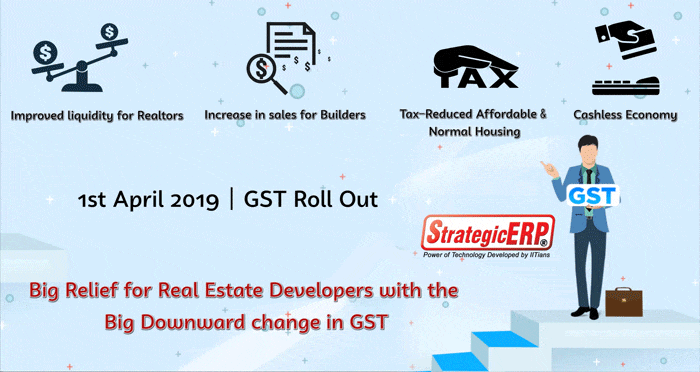Big Relief for Real Estate Developers with the Big Downward change in GST
Category :
Blog posted by : Admin / 06 Mar, 2019
Real Estate has always been an ever-growing sector in India, having its roots widely established in metro and non-metropolitan cities. Some of the factors affecting the growth of real estate sector are demand, supply, and government policies which vary according to dynamic situations in the Indian economy. But in the year 2019, to increase the demand in the real estate sector, GST council has slashed tax rates for under construction flats to 5% and affordable homes to 1%, effective from April 1, 2019. Currently, the GST is levied at 12 percent with an input tax credit on payments made for ready-to-move-in flats whereas the existing tax rate for affordable housing is 8 percent.
Trending Benefits of GST
1. Tax-Reduced Affordable and Normal Housing:
After the 33rd meeting of GST council, finance minister Arun Jaitley said that benefits of Input Tax Credit were not being passed on to customers, therefore, the council has removed the ITC (Input Tax Credit) after which the tax rates for regular housing and affordable housing properties are set to be 5 percent and 1 percent respectively. Arun Jaitley raised the concern that real estate developers will have to purchase a "very high percentage" (as decided by committee) of their inputs from GST-registered dealers. The reduction in rates will enable an ordinary person to afford a property. The burden of the indirect tax will be reduced on to a customer allowing them to consider more extensive choices for buying the property.
2. Increase in sales for Builders:
The GST council has expanded the benefit of affordable housing to those flats whose cost is 45 lac and carpet area is 60 sq meters in metro cities like Hyderabad, Mumbai-MMR, Delhi-NCR, Bengaluru, Chennai, and Kolkata. The committee has also enabled benefits to those flats whose carpet area is 90 sq meters in non-metro cities despite any cost. 60 sq meters house translate to a two-bedroom apartment in a metro, and 90 sq meter carpet area converts to a three-bedroom house in non-metros. Such policy reforms will encourage aspiring people to buy slightly bigger houses which will result in an increase in sales for real estate developers. With this policy, builders will be able to maintain the targeted profit margin with increased sales. Plus potential demand generation will outweigh all the possible negative aspect leading to higher sales and revenue.
3. Cashless Economy:
The fitment committee and law committee will soon draft guidelines and place it before the GST council to make the real estate sector have a cashless economy. Jaitley added, to ensure that the real estate sector does not go back to a cash economy, builders will have to purchase a very high percentage of goods from a GST registered dealers. It will streamline the transactions and ensure transparency between builders and inventory dealers.
3. Improved liquidity for Realtors:
Low prices of properties for customers in metro cities like Mumbai, Hyderabad, Delhi will help boost the retail housing volumes in these locations. Before the lower GST rate, customers had to wait for projects to be completed, to avoid the burden of GST (which is applicable to under-construction projects). It had further stretched the financials of under-construction projects which was restricted due to weak demand. Now with a post price reduction following lower GST rates, higher under-construction sales in metros will revamp the financial health of large real estate builders operating in these locations.







